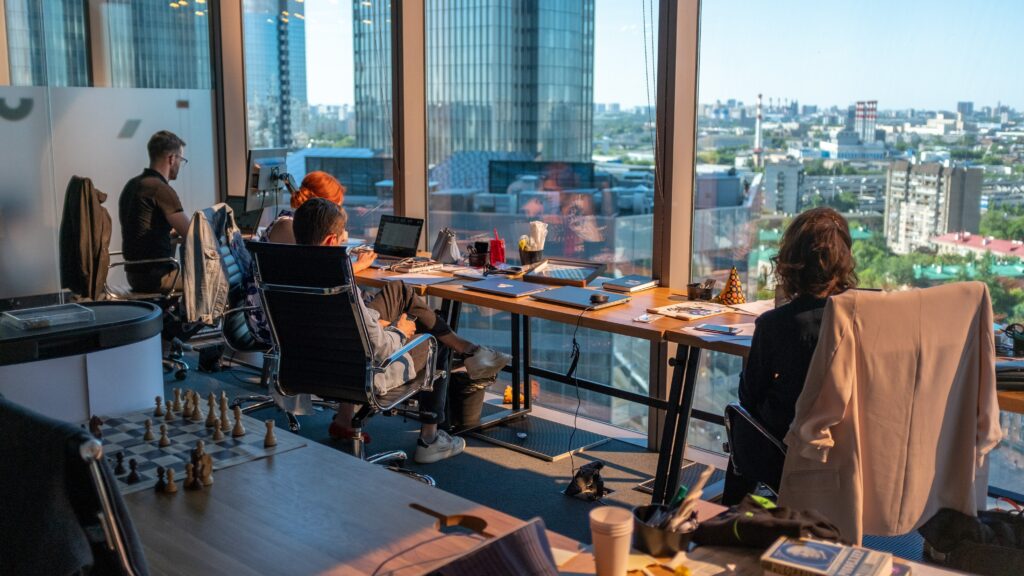
In today’s modern workplaces, optimising desk space has become crucial for promoting collaboration, creating a comfortable work environment, and even saving costs. Several practical strategies for desk space utilisation include hot desking, flexible seating arrangements, and collaborative workspaces. By implementing these strategies, organisations can make the most of their office space, enhance employee satisfaction, and foster a culture of innovation.
Hot desking is a practise that eliminates assigned desks and allows employees to choose their workspace based on their daily needs. Some people call it desk sharing or office hoteling. This strategy optimises desk space and encourages team member interaction. By implementing hot desking, employees have the opportunity to work in different areas of the hot office, fostering collaboration, knowledge sharing, and cross-functional relationships. Additionally, hot desking can lead to cost savings by reducing the amount of unused desk space.
Flexible seating arrangements provide employees with various seating options, such as standing desks, ergonomic chairs, and alternative workspaces like lounge areas, pods, or quiet zones. By offering a range of choices, organisations can cater to different work styles and preferences, ultimately improving comfort and productivity. Employees can choose a workspace that suits their needs for a particular task, whether it’s focused individual work or a collaborative project. Additionally, providing ergonomic furniture promotes employee well-being and reduces the risk of musculoskeletal issues.
Collaborative workspaces are designed to facilitate teamwork, creativity, and idea sharing. These spaces can include open-plan layouts, meeting rooms, brainstorming areas, and project-specific zones. By creating dedicated areas for collaboration, organisations encourage spontaneous discussions, problem-solving, and cross-functional collaboration. Collaborative workspaces also allow employees to learn from each other, share expertise, and generate innovative ideas. Incorporating technology tools and interactive displays in these spaces can further enhance collaboration and productivity.
Technology can significantly contribute to desk management and optimisation. Providing employees with tools such as laptops, tablets, and wireless connectivity enables them to work seamlessly from any location within the office. Additionally, implementing cloud-based collaboration platforms and project management tools can enhance productivity and facilitate teamwork, eliminating the need for excessive physical paperwork and desk space.
Designating specific zones within the office for different work activities can further enhance desk utilisation. For example, creating quiet zones for focused individual work, collaboration spaces for team discussions, and breakout spaces for informal meetings can provide employees with a variety of work environments to choose from. This flexibility allows individuals to select the most suitable workspace based on their specific needs, fostering productivity and engagement.
Effective desk utilisation goes beyond just optimising space; it also involves prioritising employee well-being and comfort. Providing ergonomic furniture, adjustable desks, and proper lighting can significantly improve employee satisfaction and productivity. Additionally, incorporating biophilic design elements like plants and natural lighting can create a more pleasant and inviting workspace. By considering employees’ physical and mental well-being, organisations can create an environment that promotes productivity and overall job satisfaction.
Implementing a desk booking solution enables employees to reserve desks in advance based on their daily needs, promoting a flexible and dynamic workspace. By leveraging such a solution, organisations can eliminate the inefficiencies associated with permanently assigned desks and ensure that workspaces are utilised to their full potential. Employees can choose a desk that best suits their daily tasks, fostering collaboration and adaptability. Moreover, the reservation system allows management to track and analyse desk usage patterns, providing valuable insights for strategic space planning. This not only minimises the chances of unused or underutilised desk space but also facilitates a more efficient allocation of resources.
Efficient storage solutions play a crucial role in optimising desk space. By minimising clutter and organising essential items, employees can maximise available workspace. Storage solutions such as filing cabinets, shelves, and desk organisers can keep desks tidy and promote a more productive work environment. Encouraging employees to adopt a paperless approach and utilise digital storage systems can reduce physical clutter and free up valuable desk space.
Optimising desk space within an office is crucial for creating a productive and efficient work environment and saving costs. By implementing strategies such as hot desking, flexible seating arrangements, and collaborative workspaces, organisations can maximise the use of available space and foster collaboration among employees. Efficient storage solutions, utilising technology, creating designated work zones, and prioritising employee well-being are additional strategies for effective desk utilisation. By embracing these strategies, organisations can create a workspace that promotes productivity, collaboration, and employee satisfaction.
To learn more about desk booking solution, click the button below
Subscribe to the monthly newsletter!
By clicking the “Subscribe” button above, you agree to the Terms & Conditions and Privacy Policy
2014 – 2025 Proudly designed and made in Lithuania